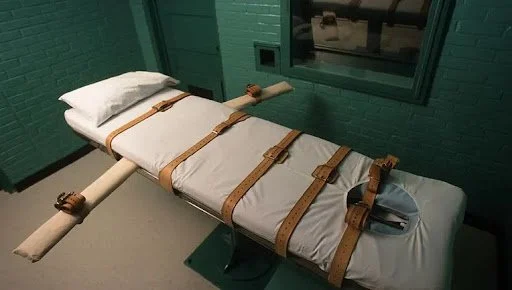Florida, Texas, Alabama, and South Carolina Lead Nation in Death Penalty Resurgence
Texas death chamber in Huntsville, TX. Source: LiveNOW Fox.
As of October 15, 2025, 38 prisoners have been executed under the death penalty in 11 states this year. 14 of these prisoners were executed in Florida, 5 in Texas, and 4 in both Alabama and South Carolina. All of these individuals were executed using either lethal injection or lethal gas. This total already greatly exceeds the 25 total executions carried out in 2024, and is the highest since 2012, when 43 inmates were executed. This uptick in executions comes after President Donald Trump urged governors to increase their use of capital punishment and pursue new death sentences for the 37 men whose death sentences were commuted to life without parole under the Biden administration. While some state prosecutors declined to cooperate due to the high costs and logistical complications associated with reinstating the death penalty, other states quickly complied.
In Florida, Texas, Alabama, and South Carolina, the death penalty is reserved for capital felonies. After a conviction, the jury must weigh the aggravating and mitigating factors and decide whether a death sentence is the proper recommendation to the judge. Most other states require a unanimous decision by the jury, but in Florida, only 8 out of 12 jurors must vote to sentence a prisoner to execution, and in Alabama, only 10 out of 12 jurors must do the same. Two of Alabama’s newest death sentences resulted from non-unanimous jury votes, with only ten jurors voting for death. Various legal scholars suggest that Alabama and Florida’s unique capital sentencing scheme jeopardizes the fairness, reliability, and constitutional integrity of death penalty cases.
Florida has an incarceration rate of 795 per 100,000 people, including prisons, jails, immigration detention, and juvenile corrective facilities. Texas has an incarceration rate of 751 per 100,000 people. Alabama has an incarceration rate of 898 per 100,000 people. South Carolina has an incarceration rate of 606 per 100,000 people. All of these states lock up a higher percentage of people than any independent democratic country in the world, and incarceration rates have only continued to grow dramatically over the last 40 years. The incredibly high incarceration rates are reflected in the fact that only these four states account for 71% of this year’s court-ordered killings.
Despite the dramatic increase in executions across the country, public support for the death penalty remains at a five-decade low at just 53% of Americans and is particularly low among Millennials and members of Generation Z. Younger generations have first encountered the issue during a period when many states either paused or abolished the death penalty, which was frequently driven by cases in which individuals on death row were later proven innocent of the crimes for which they had been convicted.
Partisanship is also a major factor in support for the death penalty and opinions about its use. The percentage of Republicans in favor of the death penalty has remained mostly constant over the past 25 years, with 77% of Republicans and independents who lean toward the Republican Party saying they favor the death penalty, while only 46% of Democrats and Democratic leaners favor the death penalty. The four states leading the pack in use of capital punishment have Republican governors, reflecting this divide.
The Supreme Court has largely deferred to state legislatures, juries, prosecutors, and governors in shaping the future of the death penalty, reflecting public sentiment through their actions rather than direct rulings. The Supreme Court tends to maintain a hands-off stance, rejecting nearly all death penalty appeals while limiting its oversight role in ensuring due process and constitutional protections. “It has been much more difficult for [prisoners] to obtain relief in innocence cases and non-innocence cases, this affects people with due process claims and other constitutional challenges…,” stated Death Penalty Information Center Communications Associate Hayley Bedard.
Executions today often reflect views from decades ago, given the long gap between sentencing and execution. New death sentences are down nearly 30% compared to the same time last year. These new death sentences reflect the decisions of today’s juries and reflect public sentiment on the death penalty.
Ultimately, the future of the death penalty will depend on whether it will continue to maintain public support. While public approval has steadily decreased, the issue remains deeply rooted in U.S. politics, often shaped by the priorities of state administrations and pressure from national leaders. At the same time, advocacy groups and growing public protests have intensified calls for the abolition of the death penalty, leading to moratoriums and legislative efforts in several states. Six more individuals are scheduled to be executed in 2025. However, the long-term trajectory of capital punishment in the United States remains uncertain. Whether this year marks a temporary resurgence or the final peak before a nationwide decline will be determined by how lawmakers, courts, and the American public respond in the years ahead.

